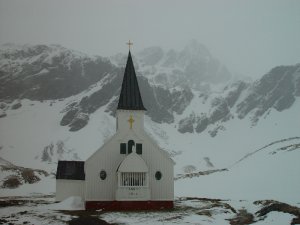Today is Ascension Day, one of those smaller church holidays that the Universalists loved a little more than expected. Let me point you back to last year’s entry, which links to other entries, including one at Philocrites.
Bookstore in church?
The anonymous author of the UK Unitarian blog praises the Unitarian Universalist Fellowship of the Poconos for opening a bookstore. OK, I think, if it is a second-hand store for fundraising, or if combined with a coffee shop, again as a fundraiser or as a community focus point, then fine. But the economics of such a shop leave me wondering.
But British Anabaptists have a string of nineteen resource houses, to complement in essence the London Mennonite Centre, covering the United Kingdom pretty well, leaving northern Wales, northern Scotland and islands deprived. Anabaptists in Holyhead, Aberdeen, and Lerwick take notice. Portsmouth, too, for good measure.
How about these for a model? One is even hosted by a Chris Walton, Philocrites‘s real name.
A South Georgia church, uh, the further, colder one
Tristan da Cunha is a veritable metropolis next to South Georgia Island, which has no permenant residents but a museum and research station, yet more tourists, and countless penguins. The only settlement — if you can call it that — is Grytviken.

It has a little church of Norwegian origins, and remarkably enough, witnessed its first wedding just a couple of months ago. The bride was named Georgia; her father visted the remote outpost years before. The church has at least once service a year: Christmas, which at least would be in austral summer!
News from South Georgia Island (includes stories about the wedding, a visit from the Falkland’s Catholic priest, and a concert in the church)
Image: Wikipedia. Released into public domain. See first two links above for source.
Sorry hun, them's the breaks
PeaceBang, I knew it was just a matter of time. Today she wrote (“Why I’m getting more Calvinistic“):
I just don’t think we can’t be trusted with just plain Self-Culture in the manner that Emerson preached it, and toward which Channing and Henry Ware, Jr.’s optimistic Christianity pointed us.
Yeah, that’s what I said a while back, and which is why today I call myself a Unitarian Universalist minister (“for identification purposes only”, as they say in the petition trade) but am by no means a Unitarian. It has made me, in part, the Universalist I am today, and that was before — both logically and chronologically — I began to profess Trinitarian theology. Why the change? A matter of observation. Most theologians, lay or ordained, tend to fall in love with the philosophy that undergirds their beliefs and will often defend their philosophy even when the roof leaks and the foundation cracks. Rookies can be forgiven, if corrected, but seasoned ideologues are a menace. That’s the difference between old and mature. Christianity suffers continually this way — how else can it be used to champion every cause under the sun? Unitarian Universalism does too.
In short, Unitarian optimism starts off as reforming vision and morphs into an astigmatic blur, if a well-written and even pithy one. It doesn’t need to, but it always seem to end there. I think what PeaceBang identifies as Calvinism is the plain observation that people don’t improve automagically. Paul’s self-reflection of doing what he doesn’t want, and not doing what he wants has always read more true than protestation of self-culture. (Romans 7:19, see also 2 Corinthians 12:7) Not so much Calvinist as experiential, and there’s nothing per se un-Unitarian Universalist about that which is one reason I can stay.
Obligatory Morrissey reference: Listen to “The Boy with a Thorn in His Side” on The Smiths album, The Queen Is Dead. (Wikipedia site) Hmm, that’s probably not a welcome sentiment in Nepal.
ΧÏιστος Aνεστη!
Past are the cross, the scourge, the thorn,
The scoffing tongue, the gibe, the scorn,
And brightly breaks the Easter morn!
Alleluia!(A. C. Jewitt)
UCC visit recap
“One. . . . two . . . . Hmm . . . Five,” said Hubby. “There are five different typefaces on the cover of this order of service.” He conceded that some were nice. And that the church we visited Sunday was beautiful.
This was his first visit, my fourth I think. We had been looking for a church to attend together — I’ll be writing more about this later — and we’ve lowered our standards. We have two grades for churches: horrible and non-horrible. We’ve not seen much else. Our demands are modest: Christian, accepts us as a couple (rather than “friends”), easy to get to, and on the liturgical side. Or we thought they were modest.
The nearby Reformed/E&R-heritage UCC church was not-horrible, and we’ll be going back. I was touched by their almost insistent hospitality, which came across as more natural and willing than in my last visit. The somewhat difficult to follow service was the liturgy printed in the front of their (old red) hymnal, which were liberally borrowed from the Book of Common Prayer. For those who know the jargon, it was Morning Prayer with Communion. Except that there was a doxological hymn — to some, the doxological hymn, “All People That On Earth Do Dwell” — before the benediction at the end: a good touch, and more true to the response of a redeemed people than the anticlimax I’ve seen at the end of, say, an Episcopalian celebration of the Eucharist. Oh, and we were “debtors.” (Hubby and I prefer to trespass.)
The lessons were neither from the hymnal’s lectionary nor the Revised Common Lectionary, but fit the pastor’s rather touching and appropriately self-disclosing sermon. (The theme was loneliness.) It wasn’t gleeming with polish and glitz, but that’s OK since it is often a fellow-traveller with Preciousness, a sin which lands churches into the horrible category.
It was a communion Sunday, and the distribution was in classes, as found in much of the Reformed family. A group of communicants comes forward, welcomed in a formula beginning “take and eat . . .” and the elements were distributed in both kinds. The bread, I swear, was a brioche. The “grape” was served in small cups in trays, with a choice of juice or wine. The “class” is then dismissed as a group, and the action is repeated until all communicate.
After the service, coffee and cookies and chat. Fun to look at old church pictures. Nice people. Better than not-horrible I think.
Who would be a Christian after a week like this?
Well, my faith is stronger when other Christians are strong in their faith.
This week has had two important Christian news stories: the rescue (thank God) of the three remaining Christian Peacekeeper Team members, and the apostasy trial and threatened death sentence of Afghan Christian convert Abdul Rahman. Interesting that certain Afghan officials are trying to use a mental incompetance tactic to spare him. If Rahman is freed and spirited out of the country, I wonder what his take on his conversion is.
In both cases, something of the peace that the world can neither give nor take away is in evidence. It also casts another pall on the idea of a religion that can be picked and chosen at will.
Tom Fox
For Tom Fox, may he dwell in the Light.
Details at the Christian Peacemaker Teams site.
Koinonia Farms documentary
I’m watching a documentary on PBS about the Koinonia Farm, near Americus, Georgia. It is called Briars in the Cottonpatch. In the lead, we’re told that most people have never heard of it. Perhaps, but it is dear to me.
- I preached from Clarence Jordan’s version of Luke — the annunication to Mary and her Magnificat — before Christmas 1995 at my student church, the Unitarian Universalist Fellowship of Arlington (Tx.). Little did I know a church member, Lora Browne, had just returned from a sojourn on personal family business so long that I had never met her . And she was one of the children of one of the three founding families, and had grown up with the community . . . and the violence. I, of course, was mortified that misstated the the facts of Koinonia. She told me two things. First, the whole community created the bible translations. Second, she thought that in preaching from that text in Texas, I should have recast the place names to Texas places. (In the Cotton Patch Version of the Bible, Rome became Washington; Jerusalem, Atlanta; and smaller places all set within Georgia.)
- In 1999 or 2000, a long-time volunteer at Koinonia organized a conference affirming universal salvation, and one of my happy times in Georgia after seminary was attending and speaking there. Just as plain and real as could be (and un-air-conditioned.)
- That Sunday, I attended worship at the Disciples church in downtown Americus. (Next to First Baptist, incidentally, if you watch the documentary.) The building was once the Universalist church in town, and the minister gave me the tour of the plant. The Universalist congregation died in the Depression, just three or four years after the terrific plant was erected!
If you enjoy this blog . . .
read Tensegrities.
I keep reading the blog by Luther Seminary professor Mary Hess, and want to read more. Sometimes I go, “Oh. I wish I had written that!”

